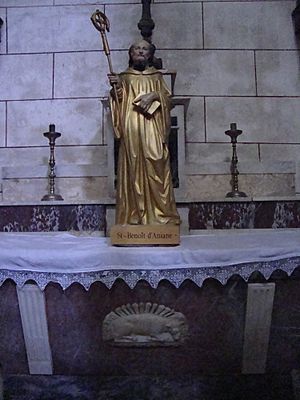Benedict of Aniane facts for kids
Quick facts for kids SaintBenedict of Aniane |
|
|---|---|
 |
|
| Born | 747 Kingdom of the Franks |
| Died | 12 February 821 |
| Venerated in | Eastern Orthodox Church Roman Catholic Church |
| Feast | 12 February |
Benedict of Aniane (Latin: Benedictus Anianensis; German: Benedikt von Aniane; c. 747 – 12 February 821 AD), born Witiza and called the Second Benedict, was a Benedictine monk and monastic reformer, who left a large imprint on the religious practice of the Carolingian Empire. His feast day is either February 11 or 12, depending on liturgical calendar.
Life
According to Ardo, Benedict's biographer, he was the son of a Visigoth, Aigulf, Count of Maguelonne (Magalonensis comes). Originally given the Gothic name Witiza, he was educated at the Frankish court of Pippin the Younger, and entered the royal service as a page. He served at the court of Charlemagne, and took part in the Italian campaign of Charlemagne in 773 where he almost drowned in the Ticino near Pavia while attempting to save his brother. The experience led him to act on a resolve which had been slowly forming in him, to renounce the world and live the monastic life. He later left the court and was received into the monastery of Saint Sequanus, the Abbey of Saint-Seine.
At Saint-Seine, Benedict was made cellarer, and then elected abbot, but realizing the monks would never conform to his strict practices he left and returned to his father's estates in Languedoc, where he built a hermitage. Around 780, he founded a monastic community based on Eastern asceticism at Aniane in Languedoc. This community did not develop as he had intended. In 782, he founded another monastery based on Benedictine Rule, at the same location. His success there gave him considerable influence, which he used to found and reform a number of other monasteries, and eventually becoming the effective abbot of all the monasteries of Charlemagne's empire.
In 781 Louis the Pious became King of Aquitaine and asked Benedict to reform the monasteries in his territory. Later as Emperor, he entrusted him with the coordination of practices and communication among the monasteries within his domains. He had a wide knowledge of patristic literature, and churchmen, such as Alcuin sought his counsel.
In 814, Louis, now emperor, had Benedict found a monastery on the river Inde near the court at Aachen. The monastery was at first called the "Monastery of the Redeemer on the Inde", but came to be known as Kornelimünster Abbey.
He was the head of a council of abbots which in 817 at Aachen created a code of regulations, or "Codex regularum", which would be binding on all their houses. Benedict sought to restore the primitive strictness of the monastic observance wherever it had been relaxed or exchanged for the less exacting canonical life. Shortly thereafter, he compiled a "Concordia regularum". Sections of the Benedictine rule (except ix-xvi) are given in their order, with parallel passages from the other rules included in the Liber regularum, so as to show the agreement of principles and thus to enhance the respect due to the Benedictine. He was primarily an ecclesiastic, who zealously placed his not inconsiderable theological learning at the service of orthodoxy, and the cause of Benedictine monasticism. Although these new codes fell into disuse shortly after the deaths of Benedict and his patron, Emperor Louis the Pious, they did have lasting effects on Western monasticism.
Benedict died at Kornelimünster Abbey on February 11, 821, in the monastery Louis had built for him to serve as the base for Benedict's supervisory work. He was buried the next day on February 12, hence why some list his feast day as the 11th and some the 12th.
Works
- For Benedict's writings, see Codex regularum monasticarum et canonicarum in Patrologia Latina, CIII, 393-702.
- Concordia regularum, ed. Pierre Bonnerue, Corpus Christianorum Continuatio Medaevalis, vol. 168/168A, Turnhout: Brepols 1999.
- Letters, PL 103:703-1380.
Other treatises (PL103:1381ff) ascribed to him are probably not authentic.
See also
 In Spanish: Benito de Aniane para niños
In Spanish: Benito de Aniane para niños
- Saint Benedict of Aniane, patron saint archive

